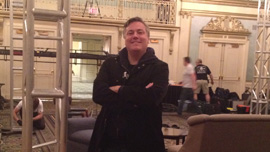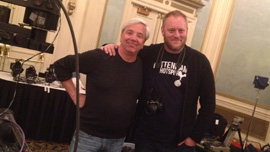TrekCore talks to Robert Meyer Burnett, one-half of the talented duo responsible for the creation of the new bonus features on Star Trek: The Next Generation‘s remastered Blu-Ray releases. Normally to be found beavering away in his edit bay, Rob generously took several hours out of his busy schedule to talk to me about all things Star Trek, answering questions about his work and dropping several juicy hints about the exciting things he and Roger Lay Jr. have planned for future Star Trek Blu-Ray releases.
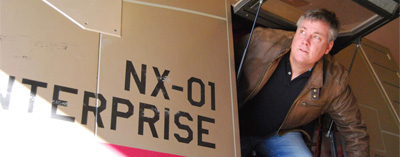
Robert Meyer Burnett: Who Interviews the Interviewer? Part 4
Interviewed by Adam Walker for TrekCore.com
![]()
TrekCore: Moving on to the other features on the set – the reunion format proves to be incredibly successful for a show like The Next Generation. The cast reunion, as I mentioned in the review, I absolutely loved it. Every single second. I could watch it over and over again and pick out new bits every time. I understand you’ve already filmed a writer’s room reunion and an art department reunion for future sets… how do you go about styling those features and putting them together?
Robert Meyer Burnett: The cast reunion was an idea Roger was talking about even before he was officially hired on – and then when we started the project, I knew that the cast was going to be brought together for the first time, including Denise Crosby, in Calgary in April 2012. I said,“Since they’re already there, if there’s a way we can get up there and do that…” It was something we talked about for months. When they finally decided to do it, it was kind of at the last minute – Roger was adamant that we had to shoot it like a network special, like it could be on CBS Television in prime time.
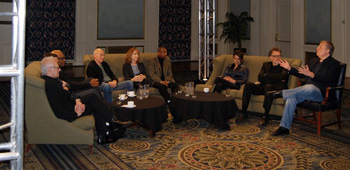
Robert Meyer Burnett sits down with the entire cast of Star Trek THE NEXT GENERATION at the a convention in Calgary for the special Cast Reunion feature on Season 2.
We actually enlisted Gary Khammar, another terrific VAM producer – he’s a great field producer – and CBS felt comfortable with him. We brought him on board to do the actual field production, to find out who the camera people were in Calgary; Phil Bishop from CBS Home Entertainment came up to head our team and sort of spearheaded for us because it was way out of our VAM budget to do it – but again, Ken Ross at CBS made sure we had the equipment to do it right.
We went up, and we were able to wrangle the cast and get them to agree to do this thing. I was thinking that we should get some kind of celebrity to host, and everyone was like, “No Rob. You’re hosting!” I’m not exactly svelte, I’m not exactly an on-camera personality! (Laughs) They said, “No, no, no – you’re personable and you know what to do, you’ll be great.” I thought that was cool… and when we got up there and I did it, it was like a dream come true for me.
Robert Meyer Burnett (left), Gary Khammar (VAM Producer and co-founder of Light Source & Imagery) and Phil Bishop (Vice President of Worldwide DVD Mastering for CBS) at the Calgary convention preparing for the epic Star Trek THE NEXT GENERATION Cast Reunion
TrekCore: That was probably the right choice, Rob, because I know they had the Star Trek Captain’s Reunion at ‘Star Trek: London’, and it was hosted by a celebrity – John Barrowman, from Torchwood – and it was good, but his personality kind of brought in a sixth element to it, which brought us away from getting to know the people we were there to see.
Robert Meyer Burnett: Right – and you’ll notice that I don’t do a lot of talking in there. My job was, again, I started out by asking what Rick Berman had said about the “three strikes” against the show – and I knew that once you got these people talking, stay out of their way! I would push the conversation when it would lull, and ask questions that I thought would generate the most discussion, but they would carry it. That was sort of my philosophy; to ask the question and get out of the way – but I also knew that I didn’t want to ask the typical questions. “Tell me about your character.” Who cares? What you want to do is see their personalities and their interaction. That’s what we were most interested in doing, and it worked out really well.
For Season Three, focusing on the writing of the show – we’ve done a piece we call “Inside the Writer’s Room” – we knew that Ted writer-director Seth MacFarlane was a fan; we’d had him in for a single interview for Season Two. He, to me, represents the fans, all of us – even though he’s a celebrity. But at the time TNG aired, he wasn’t. But he’s both a huge industry success and an uber-fan, so he was perfect to host the piece. And he’s certainly far more handsome than I am!
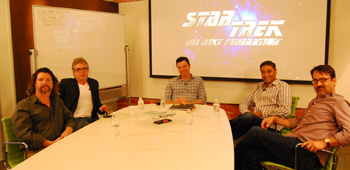
For the Season 3 Blu-Rays, Burnett and Lay produced the ultimate feature on the writers of the show, “Inside the Writer’s Room” is hosted by Seth MacFarlane (center) and features (from left to right:) Ronald D. Moore, Brannon Braga, Naren Shankar and René Echevarria.
We figured that because he already had a relationship with Brannon Braga, and he’s a writer for television himself, what better way to do the writers’ reunion than with him? So we asked, not thinking he would do it, and he did! He absolutely agreed to do it. Not only did he agree to do it, but we shot that reunion in the conference room here at our office, and then he left the reunion and got on a plane to go host Saturday Night Live! You know, you meet people in Hollywood – Seth MacFarlane is one of the greatest people that I’ve met. His intelligence, his energy, his wit; he’s one of those guys that walks into a room and lights it up. Plus, the fact that he’s resurrecting Carl Sagan’s Cosmos… he’s a guy that puts his money where his mouth is and I can’t imagine having anybody better to host this reunion. Of course, it makes us look great, because he’s been announced as the host of the Academy Awards – so CBS could not be happier with us! I’ll be extremely curious to hear the fan reaction to the Writer’s Room piece.
TrekCore: With the art department reunion – we saw some lovely photos of them all gathered together at Doug Drexler’s house – how did that come about?
Robert Meyer Burnett: That was, again, something that we had talked about from the very beginning. It’s unique in the world of motion pictures and television that you have guys like Mike Okuda, who worked on Star Trek for eighteen years – longer, if you count his work on Star Trek IV; a guy like Rick Sternbach who worked on The Motion Picture; Herman Zimmerman, who was only on the first season of The Next Generation, but from Deep Space Nine on; Doug Drexler… how many times do you have an art department that worked for so many years doing this? Herman Zimmerman is just so beloved, and to have them all come together and just shoot the shit, it was great. The stories that come out, and the camaraderie… these are things that don’t normally come out in interviews and to see that kind of thing is really tremendous.
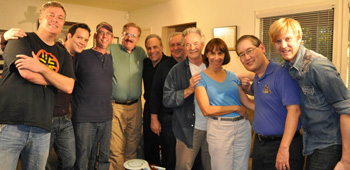
The Art Department Reunion. From left: Robert Meyer Burnett, Roger Lay Jr., Darren Barnett, Rick Sternbach, Doug Drexler, Dan Curry, Herman Zimmerman, Denise Okuda, Mike Okuda and Kris Edwards.
In hindsight, we probably should have saved the cast reunion for the end – to us, the writers’ reunion and the technical reunion are both just as interesting – the cast reunion is just so good; it has the star power, but for the true fans, getting the writers’ reunion… I mean, Ron Moore has just become such a genre luminary in his own right, having created Battlestar Galactica, and Brannon’s worked on everything from 24 to [the NBC series] Threshold, and Naren [Shankar] has been on CSI for so long – getting these guys together, the writers’ reunion, in terms of knowledge of the series and Star Trek storylines, why decisions were made, is almost more interesting to the fan than the cast reunion.
TrekCore: Where do you think you can go with this reunion format? Do you think you can take it further?
Robert Meyer Burnett: What I’d like to do, what Roger and I are talking about, is for Season Seven – I’d like to have the cast and crew get together. Like, I want to see Rick Berman sit down with the cast. I would like Rick Berman to host and moderate a discussion. I’d love to see that – have the writers, have a big blowout… if that could be done.
One of the great things I thought we were able to do for Season Two was to get Cosmo Genovese to come in – the cast just loved Cosmo. When we told the cast that that we were interviewing Cosmo, they couldn’t believe it. As you can see in the Season Two documentary – and not many people have mentioned this – when you see Cosmo reading the off-camera dialogue, it’s hilarious! Like that scene where he does Lwaxana Troi, and everyone busts up on the bridge… I mean, imagine – he was with that cast every day reading thousands of different characters and they interacted with him. The fact that we went and got him… the cast couldn’t believe it. They were like, “That is amazing!”
TrekCore: If you ask fans for their favorite VAM on Blu-rays, it’s normally outtakes, deleted scenes, and commentaries – and with Season Two, we got a couple of commentaries on two of the most popular episodes of the season, “Q Who” and “The Measure of a Man”. How do you go about choosing the participants for the commentaries, and the episodes themselves?
Robert Meyer Burnett: We would want to do commentaries on every episode, but it’s just not practical. Those two episodes, because they’re kind of special, cornerstone episodes, both picked for the Fathom events – to decide who is going to participate… the problem with the actors, and I hate to say it, is that it was twenty-five years ago. When you watch the bloopers and the outtakes, for the actors, the scenes set on the Enterprise in every episode just become a blur. The actors do not have the experience with Star Trek that we do as viewers. For them, one episode is no more significant than another. They don’t know. They show up on the bridge; every scene on the bridge seems the same to them.
They say the dialogue, and that’s it – even though we might think it’s a key episode, the beginning of such-and-such, or Sela’s back, or whatever. But the actors, they don’t know, so there’s not a lot of insight you can get from them, especially after the show’s been on for twenty-five years. Unless you’re doing it for a recent movie they’ve finished, when it’s just come out and they’ve seen it – like when we did Lord of the Rings or something – that’s different. But with these, you want to get the technical people, and you want to get the people who actually have something to say – the writers especially always have the most insightful things to say about the episodes because they wrote them!
The Okudas’ approach to commentaries is different than mine, in the sense that they really do research and they come up with great questions and great anecdotes; they tend to steer the commentaries in a certain direction. They’re not trying to have people say what they want to have said; they’re trying to provide the best information for the fans. I like to have commentaries done off the cuff – I think they both have their place – or you have people riff on the commentary, like a director and an actor, and it becomes a lot of fun. I know that Roger is off doing Enterprise commentaries – he’s got Brannon Braga and James Conway and Dan Curry; people with different perspectives.
We’d like to continue to do more commentaries. I know that Ron Moore – who did such great commentary work on Battlestar Galactica – has offered to come in and do commentaries on every one of his episodes! And, like, I can’t wait to do a commentary on “Sub Rosa”, which is an episode I learned from the writers’ reunion that everybody has very strong feelings for! (Laughs) So I’d love to do an episode where things went wrong; a commentary for an episode that isn’t the greatest.
TrekCore: You recently went to the Fathom screening of “Q Who” and “The Measure of a Man”. Tell us about it, and how you felt about your own work being put up on the big screen for thousands to see?
Robert Meyer Burnett: It was crazy seeing myself on the big screen, and it’s crazy thinking that VAM is being shown, but it’s nice to know that the documentaries, which Roger and I shoot ourselves with our own equipment – neither of us are professional videographers, but I think we do a good job with the star field composites behind everybody – but I think it looks great, and it’s really gratifying to see people laugh at the VAM, and having an emotional response. It might be strange to say, but when I’m cutting this stuff together, I’m trying to convey a story that should have an emotional response from people. It’s like when Stephen Macht shows up at the end of the Season One documentary. I have an emotional response to hearing his story, and when you can see that happen – especially during the blooper reel – it makes me feel good, you know, that our material can be put on a big screen and it is compelling. I mean, there’s not better true test of the work we’re doing than that.
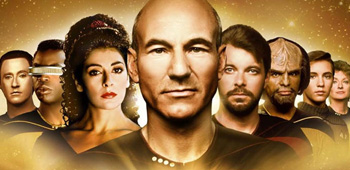
The NCM Fathom Season 2 Event showcased some of the VAM produced by Robert and Roger on the big-screen.
And I love seeing the episodes on the big screen – sure, there are people who complain about the projection and all that – the screen we watch it on in Century City is huge! It’s a massive screen! Seeing the episodes, it’s great. What’s interesting is seeing how they play that big, because even if you have a home theater system, seeing them projected that big and how well they work – I mean, “Measure of a Man”, which is essentially a bottle show, just people talking to each other, worked really, really well on the big screen. It was great.
TrekCore: Looking forward to Season Three, what are your plans for celebrating The Next Generation’s most popular season with VAM?
Robert Meyer Burnett: What I really like is the idea that for us, it’s the most successful season, it’s my favorite season of Star Trek – but for the people making it, it was a nightmare. I love the fact that Ira Behr, who later took Deep Space Nine to such heights, he worked on The Next Generation for only the third season – and boy, Ira Behr does not pull any punches. He’s got great stories to tell. But one of the things we also want to do in Season Three is a celebration of Michael Piller – who changed the writing staff forever and had his mandate that all the stories should be about the characters first, as opposed to external threats – he really changed the shape of The Next Generation. So we’ve got that coming; we’ve got the “Inside the Writer’s Room” piece… it’s really, I think for Season Three, the writers’ VAM. You have Ron Moore and Rene Echevarria selling their very first scripts to television; of course, you have the cliffhanger of “The Best of Both Worlds”… so that’s what I’m looking forward to; concentrating on the writing of that season and the changes that the show went through.
TrekCore: Looking at the bonus features so far, and what you’ve got planned for Season Three, I can’t help but thinking that as the seasons progress towards Season Seven, it’s going to become harder and harder for you guys to come up with original ideas for bonus content. Are you worried about that? Do you already have ideas for each season already?
Robert Meyer Burnett: Yeah, I do worry about that – because once you’re into the fourth season, Star Trek was pretty much a well-oiled machine. There weren’t problems. Once the show was working, every day was status quo. There are interesting ideas; Ira Behr tells this great story in Season Three about how they would not let him mention Spock in the episode “Sarek”. They wouldn’t allow it. By Season Three – especially Rick Berman – they didn’t want to mention anything to do with the old show. Ira Behr was like, “You had Doctor McCoy in the pilot!” Of course, you later had Leonard Nimoy and James Doohan come back and those things changed… They brought in family members; they brought in Sela to bring back Denise Crosby again; the Klingon Civil War, having recurring characters like Gowron and the ongoing Klingon arcs – thinks like that are what we’re going to have to basically concentrate on, because once you get into the later seasons, it all went off without a hitch. So, I’m a little worried… but we’ll come up with something!
***
ROBERT MEYER BURNETT wrote and directed FREE ENTERPRISE and produced Warner Premiere and Dark Castle’s THE HILLS RUN RED.
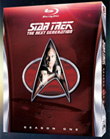 | Order Star Trek: The Next Generation Season 1 Blu-Ray today! | 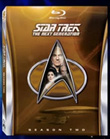 | Order Star Trek: The Next Generation Season 2 Blu-Ray today! |
|---|

